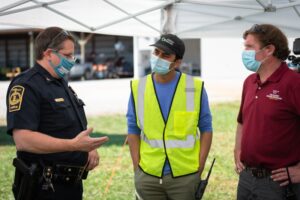Over eight days of testing, 369 drone flights launched and landed at a rural test site outside Blacksburg. In a slice of airspace that covered less than a quarter of a mile, as many as 12 aircraft were sometimes flying at once. These flights were dense by design, choreographed to answer a question that’s increasingly crucial to drone integration: How can drones share the air without bumping shoulders?
The tests, led by the Virginia Tech Mid-Atlantic Aviation Partnership (MAAP), marked the culmination of the second phase of the FAA’s UAS Traffic Management Pilot Program. UAS Traffic Management, or UTM, is the network of systems that will facilitate the growth in drone traffic by giving operators the tools to coordinate with each other.
This is MAAP’s fifth year of large-scale UTM testing and its second year in the FAA program. This test series was more complex than anything they’ve conducted before, stress-testing the technology’s ability to handle unexpected events and engaging a range of stakeholders as UTM moves closer to implementation. MAAP, an FAA-designated UAS test site, partnered on the tests with four companies developing UTM solutions: AirMap, AiRXOS (part of GE Aviation), ANRA Technologies, and Wing.
“Building a UTM system that can allow multiple drone operations to safely share the same geographical area is a very complex problem,” said MAAP director Mark Blanks. “Operators with different aircraft, different software, different flight plans all need to be able to access real-time information about each other’s missions, as well as data on weather conditions, manned aircraft nearby, and other factors that might affect their ability to conduct their flight safely.”
Through the UTM system, a drone operator planning a mission accesses information about other flights in the area. When a flight launches, data from the drone flows back into the UTM system, contributing to a continuously updated portrait of the airspace that alerts operators to potential problems.
Today, early in the arc of drone integration, drone flights are still sparse and unlikely to interfere with each other. But as more businesses, public safety organizations, and other users incorporate drones into their work, the kind of cooperative planning and information-sharing that UTM enables will become imperative — particularly as more permissions are granted for flights that take the drone beyond the operator’s visual line of sight.
“Just like in the early days of aviation, people didn’t consider initially that you would need to have these kinds of services,” said John Coggin, MAAP’s chief engineer. “But if we’re going to see the real benefits of drones we really need to have a solution that scales safely and manages larger volumes of aircraft and higher density operational environments. Imagine urban areas with lots of deliveries and public safety aircraft that need to be able to take priority. All of these things need to be accommodated within the UTM system.”

UTM development is primarily industry-led, though the overarching research effort has been overseen by the federal government — originally by NASA, in a multiyear test series that MAAP was also heavily involved in, and now by the FAA.
To put the four software platforms through their paces, MAAP’s engineers designed a series of tests based on realistic scenarios that would require nearby drone operations to coordinate with each other. Different operators used different software platforms, which is what will happen in real-world drone operations, too. A key parameter the team evaluated was whether the different platforms could communicate fluently with each other to provide a unified picture of the airspace.
Another primary requirement for a UTM system is that it has to be able to function smoothly in a dynamic environment, providing updates that will allow operators to adapt to changes quickly and safely. The test series deliberately introduced a variety of unexpected events — for example, a drone that had veered off-course and created a collision risk, or a request to reserve a section of airspace for a search and rescue operation by public safety officials.
The researchers tested the platforms’ ability to pull in data about nearby manned aircraft flights, with the help of a team from Star Flight Training — based in Roanoke — who flew a small airplane over the test area in a carefully controlled encounter. The UTM system utilized both ADS-B and a ground-based radar to track the manned aircraft and notify the drone operators.
Remote ID tools being developed by each of the four companies were also evaluated during the tests. Remote ID is intended to help the public and public safety officials understand more about drone flights they may see in their area, crucial for cultivating public confidence as drone operations expand. The FAA is expected to release rules for Remote ID requirements later this year.
Public-safety officials, who need to be able to investigate drone operations that may violate regulations or create a risk, also have a vested interest in the rollout of Remote ID. To get a glimpse of the state of the art for these services and weigh in on what features matter most for public safety, Virginia Tech police officers and emergency management officials dropped by the site for a demo on one of the test days.
MAAP and the FAA presented the results of these tests in a virtual executive showcase, which included a panel discussion with representatives from each of the four partners. A recurring theme during the event was the role this data will play in shaping emerging industry standards for Remote ID and UTM, which are essential for establishing a common foundation in this rapidly evolving industry.
The showcase’s guests included a broad cross-section of the FAA, state-level aviation stakeholders, industry partners, and representatives from regulatory agencies in several other countries.
“This research activity is not done in a vacuum — it’s not just Virginia Tech working with the FAA,” Coggin said. “All the stakeholders are here at the table and involved in the research, and they’re helping form the solutions that will ultimately be implemented.”

